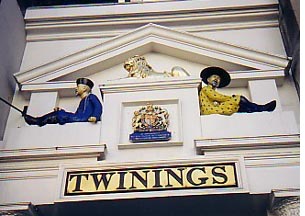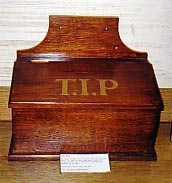It's Always Tea-Time at Twining's
by Elise Warner
H.R. Twining & Co., Ltd, London, a trailblazer in specialty teas for almost three centuries, began with the purchase of Tom's Coffee House by Thomas Twining in 1706. Located in the rear of its present site at 216 Strand, it attracted gentlemen and scalawags who engaged in serious discussions and frivolous chatter while indulging in brandy, rum and arrack (an alcoholic drink distilled from rice or molasses) and drinking water from Bath and Bristol. Thomas soon offered a new drink that had begun to gain favor with the public Ð tea. Of course, a woman of social standing never placed her dainty foot inside a coffee house; a lady would wait in her carriage while a manservant fetched the refreshment.
Eleven years later, Thomas opened The Golden Lyon. Despite high taxes and dire warnings issued by the medical profession and the church against the brew, tea became fashionable and members of Court Circles and the Royal Household patronized the establishment.
 In 1797, Tom's grandson, Richard Twining, built a doorway on the Strand opposite the Royal Courts of Justice. Above the shop's Royal Crest, centered between two colorful Chinese figures, he incorporated the symbol of the Golden Lyon, attracting the eye of the beholder to The House of Twining. The fragrance of choice teas and coffees wafts past the entrance; an irresistible invitation to the passerby. Teas range from Prince of Wales, Orange Pekoe, Earl Grey, Darjeeling, China Black or Lady Grey to the finest Assam plus a selection of over 13 different types of coffee.
In 1797, Tom's grandson, Richard Twining, built a doorway on the Strand opposite the Royal Courts of Justice. Above the shop's Royal Crest, centered between two colorful Chinese figures, he incorporated the symbol of the Golden Lyon, attracting the eye of the beholder to The House of Twining. The fragrance of choice teas and coffees wafts past the entrance; an irresistible invitation to the passerby. Teas range from Prince of Wales, Orange Pekoe, Earl Grey, Darjeeling, China Black or Lady Grey to the finest Assam plus a selection of over 13 different types of coffee.
Accompanying the teas are an assortment of fine crackers and jams, neckties, aprons, tea towels, mirrors, bone china mugs, cups and saucers, coffee makers, limited edition teapots and teapots shaped like bears, vegetables and birdhouses.
 A portrait of the founder, attributed to William Hogarth, welcomes memorabilia addicts to the Museum at the rear of the shop. Displayed are a copy of the Royal Warrant issued to Richard Twining II by Queen Victoria in 1837, a Buddha, carved from the roots of a tea bush, invoices dating back to 1715 and pictures of Thomas and his son Daniel on a 1737 tea wrapper. Maps and advertisements for tea, coffee, chocolate, sage and snuff adorn the walls along with prints of tea trading. One that appeared in the London Chronicle, in 1770, states business would continue as usual despite a warehouse fire.
A portrait of the founder, attributed to William Hogarth, welcomes memorabilia addicts to the Museum at the rear of the shop. Displayed are a copy of the Royal Warrant issued to Richard Twining II by Queen Victoria in 1837, a Buddha, carved from the roots of a tea bush, invoices dating back to 1715 and pictures of Thomas and his son Daniel on a 1737 tea wrapper. Maps and advertisements for tea, coffee, chocolate, sage and snuff adorn the walls along with prints of tea trading. One that appeared in the London Chronicle, in 1770, states business would continue as usual despite a warehouse fire.
The back room is also home to Victorian tea tins, the first Twining illustrated advertisement for packet tea (introduced during the 19th century,) and 19th century tea scales. Models and photos of delivery vans (with and without horses,) and an Edwardian double teapot are exhibited along with a T.I.P. -- To Insure Promptness -- box. The box was nailed to the wall in coffee houses and parched patrons who desired good service would place money in the box.
Damaged during the Second World War, 216 Strand was rebuilt in 1952 ensuring its reputation as the oldest company (Teamen to connoisseurs, by appointment to Her Majesty Queen Elizabeth II) to have traded continuously on the same site.
More Information:
We regret that we no longer have the resources to maintain up-to-date links and/or hours and pricing details for the various sites and attractions listed on this website. For more information about the location(s) listed above, please use your favorite search engine or visit Wikipedia.
Elise Warner's articles have been published in The Travel Section of The Washington Post and in magazines such as Rock & Gem, Historic Traveler, Animal Watch, Kaleidoscope, 50 and Forward and Pennsylvania and on-line at literarytraveler.com and internationalliving.com.
Article and photos © 2005 Elise Warner
|
